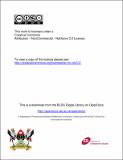| dc.contributor.author | Lwanga-Lunyiigo, Samwiiri | |
| dc.coverage.spatial | Uganda | en |
| dc.date.accessioned | 2015-01-28T14:13:16Z | |
| dc.date.available | 2015-01-28T14:13:16Z | |
| dc.date.issued | 1993 | |
| dc.identifier.citation | Lwanga-Lunyiigo, S. (1993). “Uganda's long connection with the problem of refugees: From the Polish Refugees of World War II to the Present". Makerere Institute of Social Research. | en |
| dc.identifier.uri | https://opendocs.ids.ac.uk/opendocs/handle/20.500.12413/5693 | |
| dc.description | Makerere Institute of Social Research (MISR) workshop on “Uganda and refugee problems” 20th December 1993, in the Lower Lecture Theatre, Faculty of Arts Makerere University. | en |
| dc.description.abstract | Between l942 and 1944 7,000 Polish refugees, mainly women and children, were received in Uganda. They were settled in two camps, Nyabyeya, in Masindi District and Koja (Mpunge) in Mukono District. In 1948 most of these refugees were resettled in Britain, Canada and Australia. Some of the remainders took up employment in Uganda and in the other former British Colonies of Eastern and Central Africa. The “hard core” cases (those refugees who could not easily be absorbed in Europe because they were very old and infirm or those with criminal records) remained at the Koja Camp until 1952 when the camp was finally closed down and its assets disposed of. | en |
| dc.language.iso | en | en |
| dc.publisher | Makerere Institute of Social Research | en |
| dc.rights.uri | http://creativecommons.org/licenses/by-nc-nd/3.0/ | en |
| dc.subject | Migration | en |
| dc.subject | Population | en |
| dc.subject | Social Protection | en |
| dc.title | Uganda's long connection with the problem of refugees: From the Polish refugees of World War II to the present | en |
| dc.type | Article | en |
| dc.rights.holder | Makerere University | en |


